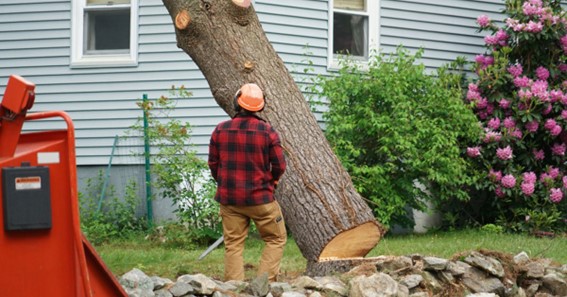Tree removal is usually a tree care company’s last resort, but it’s sometimes unavoidable. You work hard to maintain your trees healthy, but sometimes you must eliminate one (or even a few). Tree removal protects your home, yard, and loved ones from hazards.
Why Remove Trees?
Unless your tree removal demands are aesthetic, you’ll likely call a contractor because you’re worried about your yard’s trees. Before scheduling a tree check, notice any frequent tree issues below. If you’re unsure of a problem, an expert can tell you if they can rescue your tree.
- Dead, damaged, or sick? Dead and damaged trees might fall and harm you and your home. Remove an unhealthy tree that you can’t treat to safeguard adjacent trees.
- Is your backyard overcrowded? Perhaps you’re clearing your backyard or planning a construction project.
- Too close to your home or other buildings? You should also remove trees near homes or other structures.
- Is there a leaning tree? A certified arborist should analyze the condition. Root problems could cause the tree to topple.
- Fallen tree? It’s better to remove a fallen tree, especially if it’s on neighboring trees. Determine who’s accountable for removing a tree that fell between properties.
Tree removal is a dangerous job best left to experts. Qualified arborists would evaluate these factors before removing your tree:
- tree’s height
- Your home, garage, electrical lines, or a neighbor’s residence
- Tree’s fall direction
- During removal, unexpected issues like rotten limbs can fall.
- Chainsaws, wedges, cranes, and other specialist equipment are needed to remove the tree.
- Don’t attempt a massive tree removal alone. Professional tree service offer ability, knowledge, quickness, and safety.
Estimating tree removal
Size, type, condition, and location determine tree removal cost. Before choosing a company, know what’s involved.
- Included. Depending on the company, tree removal comprises cutting the tree to a stump, removing the limbs, and chopping up the trunk.
- Missing. Grinding, chipping, hauling, trunk, and splitting can be extra.
Tree Removal Techniques:
Size, location, and condition determine how to remove a tree. Tree care professionals know how to remove a tree safely, protecting people and property.
Stumping
Standing trees are felled. Miscalculated tree falls can crush persons, vehicles, or structures—six steps to felling a tree.
- A pro will check for impediments before falling a tree. They’ll inspect the tree. When cut down, damaged or dead trees might fall suddenly or in an unanticipated direction.
- Then, arborists decide which way the tree should fall. They create escape routes and ensure they are based on the direction of the fall.
- Your tree care professional will use an undercut and a back cut to fall the tree unless it requires another approach (such as crane-assisted removal).
- The undercut is constructed on the tree’s fall-facing side. The arborist will chainsaw a V into the tree.
- The rear cut is made on the other side of the tree, above the notch. The back cut does not go through the tree, leaving a portion of the trunk as a hinge. Uncut tree portion controls fall.
- Once the cuts are done, the tree will collapse, and your tree pro will turn off their chainsaw and rapidly retreat. The limbing and bucking can begin after the tree falls.
Tree limbing removes branches (either from a standing or felled tree). Bucking entails chopping a downed tree. Limbing and bucking make tree removal easier.
Tree removal helped by a crane
Chopping down a tree piece by piece and then removing the fragments with a crane is called crane-assisted tree removal. For particularly giant trees and in urban settings, this is frequently utilized. Some businesses own cranes and other substantial equipment, while others rent it.
A tree care expert may climb up in the tree to perform the removal for some crane-assisted projects while wearing a harness and other essential safety gear. Before being cut with a chainsaw, each piece of the tree is fastened with a rope or chain tied to the crane. The portion is then removed from the tree and lowered to the ground by the crane.
In other instances, the business will send in a bucket truck, and the operator will make the cuts once a worker wearing a harness has fastened the limb or trunk portion to the crane.
Watching videos of this tree removal technique is incredibly impressive, so look them up. Once you watch it, you’ll realize how dangerous this tree removal method is and why it’s necessary to have the proper training and tools.






